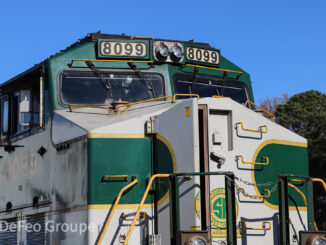
The Western & Atlantic Railroad operated some of the earliest locomotives in Georgia and the Southeast.
The road, built and owned by the state of Georgia, acquired 10 locomotives during the 1840s. The following profiles and information about these early locomotives are based on Western & Atlantic annual reports and information from the Southern Museum of Civil War & Locomotive History.
Florida
Its earliest locomotive, the Florida, a 4-2-0 built in 1837, initially served on the Georgia Rail Road before it was transferred to the Western & Atlantic. It entered service on the latter in December 1842, where it pulled the first excursion train over the line in December 1842.
By the end of the decade, the locomotive was used more sparingly.
Between Sept. 30, 1847, and Sept. 30, 1848, for example, the steamer was used for passenger service, but reported 8,800 miles in service and was listed as “laid up” in the railroad’s 1848 report. It saw no miles in service between Sept. 30, 1848, and Sept. 30, 1849, and was similarly listed as “laid up for repairs” in the 1849 report.
By the 1850 report, the steamer was listed “on (the) road in complete order,” but saw just 926 miles in service between Sept. 30, 1849, and Sept. 30, 1850. It was in the shop in 1851, 1852, 1854 and 1857. It was listed as condemned in 1858 and 1859 and worn out and condemned in 1860.
Alabama
The Western & Atlantic purchased another early locomotive, the Alabama, in 1845. This locomotive, also a 4-2-0, was built in 1838 and entered service on the State Road in September 1845.
The locomotive was in use for passenger service in 1848 and saw 21,000 miles between Sept. 30, 1847, and Sept. 30, 1848. By Sept. 30, 1849, the locomotive was in use west of the tunnel and operated 4,200 miles between Sept. 30, 1848, and Sept. 30, 1849.
By the 1850 report, however, the steamer was used for ditching. It was abandoned by the latter half of 1852, according to records.
Yonah
Arguably the railroad’s most famous early locomotive was the Yonah, which saw action during the Great Locomotive Chase. At the time, Cooper Iron Works was leasing the engine.
In addition to being the best-known of the early locomotives, it was also the longest-tenured with the road.
Rogers, Ketchum & Grosvenor built the steamer, which entered service in April 1849. It appears the Yonah was heavily used from the start for passenger service, notching 13,065 miles in service between April 1849 and Sept. 30, 1849.
Between Sept. 30, 1849, and Sept. 30, 1850, the Yonah was the most heavily used locomotive on the Western & Atlantic, running 29,416 miles during the year pulling passenger trains.
By 1855, the locomotive was relegated to switching duty, though it returned to passenger duty the next year. In 1857, the railroad used the Yonah for gravel duty and returned it to switching service in 1858.
The railroad listed the locomotive in freight duty in its 1861 and 1862 annual reports. In 1866, it was assigned to the machine shows, and in 1868 and 1869, the railroad recorded the Yonah as stationary. In 1873, it was condemned and presumably scrapped.
Locomotives
| Locomotive | Builder | Entered Service | Disposition |
|---|---|---|---|
| Florida | Baldwin | December 1842 | Listed as condemned in 1858 and 1859 and worn out and condemned in 1860 |
| Alabama | Baldwin | September 1845 | Listed as abandoned in 1852 |
| Chattanooga | Baldwin | January 1847 | Sold by 1855 |
| Connasauga | Baldwin | February 1847 | Listed as permanently disabled and condemned in 1854 |
| Tuscaloosa | Baldwin | March 1847 | Listed in 1860, but removed by 1861 |
| Monterey | Rogers, Ketchum & Grosvenor | November 1847 | Listed in good order in 1857, but removed by 1858 |
| Chickamauga | Baldwin | May 1848 | Listed as worn out and condemned in 1860 |
| Talulah | Baldwin | May 1848 | Listed as condemned in 1859 and worn out and condemned in 1860 |
| Yonah | Rogers, Ketchum & Grosvenor | March 1849 | Listed as condemned in 1873 |
| Toccoa | Norris | August 1849 | Gone by 1866 |





